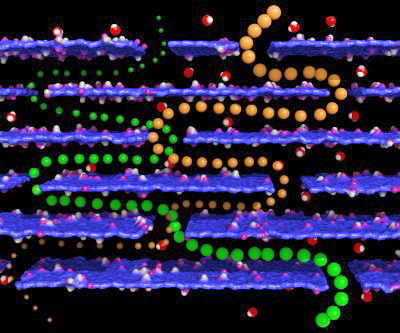Graphene ‘nano-channels’ may hold key to neural signalling, power storage
THE MONASH Centre for Atomically Thin Materials (MCATM) at Monash University, Melbourne, has discovered a new, inexpensive and reliable method for studying the way ions move through tiny, nanosized channels.
This research could hold the key to applications such as high-power energy storage, efficient desalination, and bioelectronics such as modulation of neural signalling.
Using a process similar to paper-making, researchers at MCATM have developed a graphene-based technique to make nanochannels which is simple, inexpensive and easily scalable. 
According to the first author of the research, Chi Cheng, a postdoctoral researcher from MCATM, ”The work demonstrates an unconventional way to use graphene to make nanofluidic devices, a novel research tool tuneable at length scale ranges that cannot be achieved with any other material.
“With this, we are able to unveil the fundamental, yet unusual ion transport behaviours as a function of channel size across the entire sub-10 nm length scales,” Dr Cheng said.
Simply by stacking multiple layers of graphene sheets, Dr Cheng and colleagues have created a macroscopic membrane material, which houses a series of cascading nano-slits. The minute openings in the membrane are like a maze, which the ions must travel through, allowing the researchers to observe and understand the movement of ions under a restriction level below 10 nanometers.
It is light years ahead of the former method of studying nano-confined ionic transport, which involved cutting nano channels in a process known as photolithography. This method was costly, had low success rates, and resolution limits.
Through manipulating the weak interactions among neighbouring graphene layers, the interlayer spacing can be readily adjusted. Counterintuitively, ions have been seen moving at a much higher rates as the spacing decreases, speeding through the tortuous paths between graphene layers under electric potential.
Computer simulations provided an indispensable tool in Dr Cheng’s study, complimenting his experiments, which probed the ionic transport properties in the graphene membranes.
Senior lecturer Jefferson Zhe Liu, one of the supervisors of this research with expertise on continuum and atomistic simulations, said the study revealed an anomalous scaling relation for ion transport in the unique cascading nano-slit system enclosed in graphene membranes.
“A combination of tuneable graphene membranes in experiments and computer simulations allow us to obtain a statistically representative microstructure model of the unique cascading nanoslits in graphene membranes, which was not attainable in previous studies,” Dr Liu said.
Research lead and director of MCATM, Dan Li, was enthusiastic about the potential impact of this development.
“Nano-confined ion transport, or nanoionics, is crucial to new technologies related to energy, water, and biomedicine,” Professor Li said. “It has been challenging to quantitatively study nanoionics because of the lack of nano-ionic materials with the feature size tuneable across the critical nanometer scale. The ease of scalable production and excellent structural tuneability makes our graphene membranes promising as an exceptional experimental platform to explore new and exciting nanoionic phenomena.
“It also makes it very easy to transfer the fundamental discoveries to technological innovations, enabling new generation hi-tech in energy storage and conversion, membrane separation and biomedical devices.
“This is a very exciting area we plan to pursue in the coming years,” Prof. Li said.
ends

